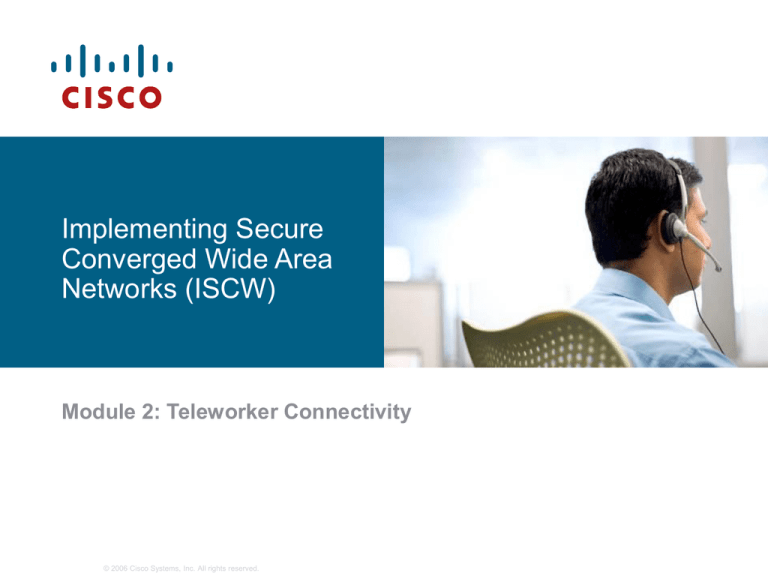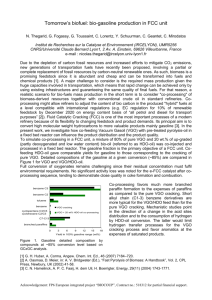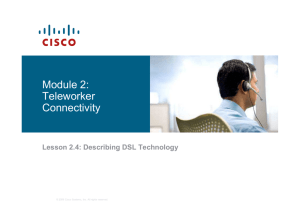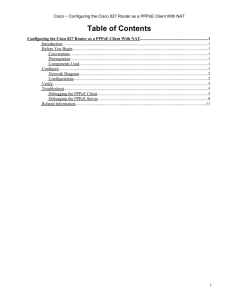
Implementing Secure
Converged Wide Area
Networks (ISCW)
Module 2: Teleworker Connectivity
© 2006 Cisco Systems, Inc. All rights reserved.
Module 2:
Teleworker
Connectivity
Lesson 2.7: Verifying Broadband ASDL Configurations
© 2006 Cisco Systems, Inc. All rights reserved.
Objectives
Describe and implement a bottom up troubleshooting
technique for ADSL.
© 2006 Cisco Systems, Inc. All rights reserved.
Determining the Layer to Troubleshoot
Non-functioning
ADSL Service
Examine Layer 1
Layer 1
OK?
YES
NO
Fix the problem
Examine
Layer 2
Layer 2
OK?
NO
Fix the Problem
YES
Examine
Layer 3
NO
Fix the Problem
Done
© 2006 Cisco Systems, Inc. All rights reserved.
Determine Whether the Router Is Properly
Trained to the DSLAM
router#
show dsl interface atm number
Displays information specific to the ADSL for a specified ATM
interface
Router#show dsl interface atm 0
ATU-R (DS)
Modem Status:
Showtime (DMTDSL_SHOWTIME)
DSL Mode:
ITU G.992.1 (G.DMT)
ITU STD NUM:
0x01
Vendor ID:
‘ALCB’
Vendor Specific: 0x0000
Vendor Country:
0x00
Capacity Used:
97%
Noise Margin:
5.0 dB
Output Power:
9.5 dBm
<...part of the output omitted...>
Interleave
Fast
Speed (kbps):
7616
0
<...rest of the output omitted...>
© 2006 Cisco Systems, Inc. All rights reserved.
ATU-C (US)
0x1
‘GSPN’
0x0002
0x00
100%
6.0 dB
12.0 dBm
Interleave
896
Fast
0
Troubleshooting Layer 1 Issues
Router is not properly trained.
Check the ADSL_CD light:
ADSL_CD light is on: Proceed to Layer 2 troubleshooting
ADSL_CD light is off: Continue with Layer 1 troubleshooting
Check whether the DSL (ATM) port on the Cisco router
is plugged into the wall jack; if not, connect the port to
the wall jack with a standard telephone cable (4-pin or
6-pin RJ-11 cable).
Check if cable pinouts are correct.
Replace any faulty cable.
Verify with your service provider that DSL service has
been enabled.
© 2006 Cisco Systems, Inc. All rights reserved.
Troubleshooting Layer 1: Is the ATM Interface
in an Administratively Down State?
ATM interface is administratively disabled.
router#show interfaces atm 0
ATM0 is administratively down, line protocol is down
<...rest of the output omitted...>
Enable administratively disabled interface.
router#configure terminal
Enter configuration commands, one per line. End with CNTL/Z.
router(config)#interface atm 0
router(config-if)#no shutdown
router(config-if)#end
router#copy running-config startup-config
© 2006 Cisco Systems, Inc. All rights reserved.
Troubleshooting Layer 1: Is the DSL Operating
Mode Correct?
Check the DSL modulation type used with the service
provider.
If modulation is not known, use the default auto
operating mode for autodetection.
router(config-if)#
dsl operating-mode {auto | ansi-dmt | itu-dmt |
splitterless}
Modifies the operating mode of the DSL for an ATM
interface
© 2006 Cisco Systems, Inc. All rights reserved.
Troubleshooting Layer 2 Issues
Verify that a PVC is in use with the ping atm interface
atm command.
router#ping atm interface atm 0 2 32 seg-loopback
Type escape sequence to abort.
Sending 5, 53-byte segment OAM echoes, timeout is 2 seconds:
!!!!!
Success rate is 100 percent (5/5), round-trip min/avg/max = 58/58/58 ms
Check the VPI/VCI settings with the debug atm events
command.
router#debug atm
2d16h: Data Cell
2d16h: Data Cell
2d16h: Data Cell
events
received on vpi = 2 vci =32 PPPoA MUX
received on vpi = 2 vci =32 PPPoA MUX
received on vpi = 2 vci =32 PPPoA MUX
© 2006 Cisco Systems, Inc. All rights reserved.
Layer 2 Troubleshooting: Is Data Being
Received from the ISP?
router#show interfaces atm 0
ATM0 is up, line protocol is up
Hardware is DSLSAR (with Alcatel ADSL Module)
MTU 4470 bytes, sub MTU 4470, BW 128 Kbit, DLY 1600 usec,
reliability 255/255, txload 1/255, rxload 1/255
Encapsulation ATM, loopback not set
Keepalive not supported
Encapsulation(s):AAL5, PVC mode
24 maximum active VCs, 256 VCS per VP, 1 current VCCs
VC idle disconnect time:300 seconds
Last input 01:16:31, output 01:16:31, output hang never
Last clearing of "show interface" counters never
Input queue:0/75/0 (size/max/drops); Total output drops:0
Queueing strategy:fifo
5 minute input rate 0 bits/sec, 0 packets/sec
5 minute output rate 0 bits/sec, 0 packets/sec
512 packets input, 59780 bytes, 0 no buffer
Received 0 broadcasts, 0 runts, 0 giants, 0 throttles
0 input errors, 0 CRC, 0 frame, 0 overrun, 0 ignored, 0 abort
426 packets output, 46282 bytes, 0 underruns
0 output errors, 0 collisions, 2 interface resets
0 output buffer failures, 0 output buffers swapped out
© 2006 Cisco Systems, Inc. All rights reserved.
Troubleshooting Layer 2: PPP Negotiation
PPP stages:
LCP phase
Authentication phase
NCP phase
Use the debug ppp negotiation command to
verify the PPP negotiation process.
Use the debug ppp authentication command to
verify PPP authentication.
© 2006 Cisco Systems, Inc. All rights reserved.
Troubleshooting Layer 2: Is PPP Negotiating
Successfully?
06:36:03: Vi1 PPP: Treating connection as a callout
06:36:03: Vi1 PPP: Phase is ESTABLISHING, Active Open [0 sess, 1 load]
06:36:03: Vi1 PPP: No remote authentication for call-out
06:36:03: Vi1 LCP: O CONFREQ [Closed] id 1 len 10
06:36:03: Vi1 LCP:
MagicNumber 0x03013D43 (0x050603013D43)
<...part of the output omitted...>
06:36:05: Vi1 LCP: State is Open
06:36:05: Vi1 PPP: Phase is AUTHENTICATING, by the peer [0 sess, 1 load]
06:36:05: Vi1 CHAP: I CHALLENGE id 9 len 26 from "nrp-b"
06:36:05: Vi1 CHAP: Using alternate hostname client1
<...part of the output omitted...>
06:36:05: Vi1 CHAP: I SUCCESS id 9 len 4
06:36:05: Vi1 PPP: Phase is FORWARDING [0 sess, 1 load]
06:36:05: Vi1 PPP: Phase is AUTHENTICATING [0 sess, 1 load]
06:36:05: Vi1 PPP: Phase is UP [0 sess, 1 load]
06:36:05: Vi1 IPCP: I CONFREQ [REQsent] id 1 len 10
06:36:05: Vi1 IPCP:
Address 8.8.8.1 (0x030608080801)
06:36:05: Vi1 IPCP:
Address 9.9.9.2 (0x030609090902)
<...part of the output omitted...>
06:36:05: Vi1 IPCP: State is Open
06:36:05: Di1 IPCP: Install negotiated IP interface address 9.9.9.2
06:36:05: Di1 IPCP: Install route to 8.8.8.1
06:36:06: %LINEPROTO-5-UPDOWN: Line protocol on Interface Virtual-Access1,
changed state to up
© 2006 Cisco Systems, Inc. All rights reserved.
Summary
ADSL service problems can reside at Layer 1, Layer 2,
or Layer 3. Troubleshooting should start by determining
which ADSL service layer is failing. To determine which
layer has a problem start troubleshooting at Layer 1
and move to subsequent layers as required.
© 2006 Cisco Systems, Inc. All rights reserved.
Q and A
© 2006 Cisco Systems, Inc. All rights reserved.
Resources
RFC2516 A Method for Transmitting PPP over Ethernet
(PPPoE)
http://www.faqs.org/rfcs/rfc2516.html
PPoE
http://www.cisco.com/en/US/customer/tech/tk175/tk819/tsd_tec
hnology_support_protocol_home.html
RFC1483 Multiprotocol Encapsulation Over ATM
Adaptation Layer 5
http://www.faqs.org/rfcs/rfc1483.html
PPPoE / PPPoA
http://www.cisco.com/en/US/customer/tech/tk175/tk819/tsd_tec
hnology_support_protocol_home.html
© 2006 Cisco Systems, Inc. All rights reserved.
© 2006 Cisco Systems, Inc. All rights reserved.











